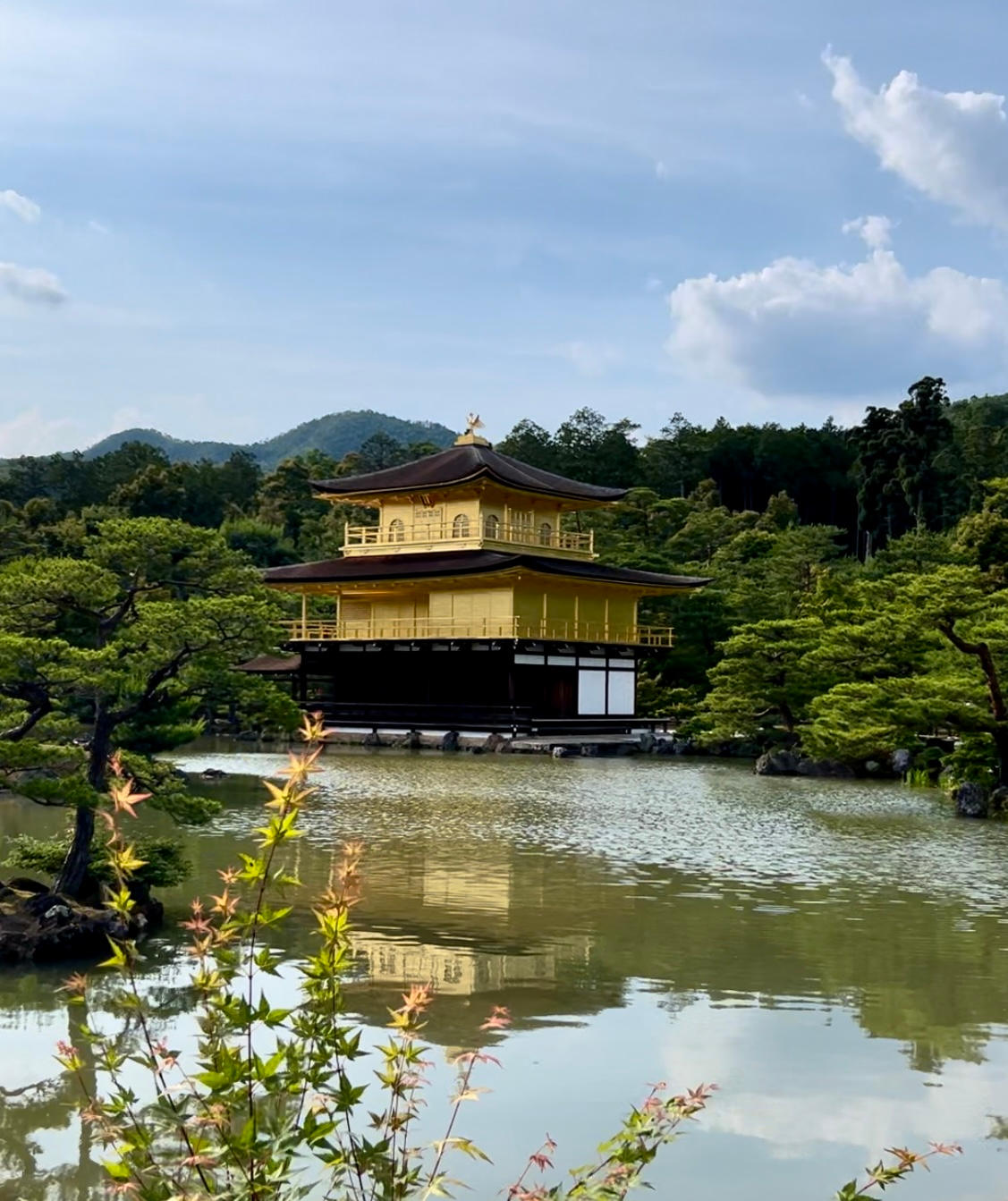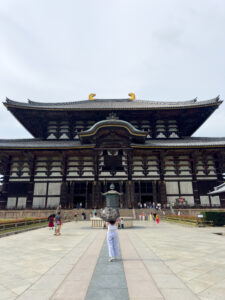
After stepping onto the grounds of Rokuon-ji, I saw the iconic Kinkaku-ji, or Golden Pavilion, emerge from a stand of pines with an almost mythical presence. The reflection in the still waters of the Kyoko-chi Pond was flawless, a perfect mirror image that shimmered like a mirage.
The interaction between the light and water created a mesmerizing spectacle, a testament to the centuries of artistic refinement that define Kyoto’s cultural heritage. This was more than a postcard come to life: it was a physical connection to Kyoto’s history and a story waiting to be told.
Centuries ago, the scene before me would have unfolded quite differently. This vision of shimmering gold wasn’t originally intended as a spiritual sanctuary. Built in the late 14th century, the Kinkaku-ji we see today began life with a far more worldly purpose.
Step back in time to the Muromachi period, an era known for its flourishing arts and powerful shōguns. It was then that Ashikaga Yoshimitsu, a renowned leader and patron of the arts, commissioned the construction of this very structure.
But instead of a temple dedicated to quiet contemplation, Yoshimitsu envisioned a luxurious retirement villa. This shimmering structure was to be a testament to his refined taste, a physical embodiment of the extravagant Kitayama culture that flourished during his reign. Here, amidst the tranquility of Kyoto’s northwestern hills, Yoshimitsu dreamt of indulging in the arts and reflecting on his legacy.
However, upon Yoshimitsu’s death, the villa underwent a fascinating transformation. In accordance with his wishes, it was converted into a Zen temple. This shift embodied the Muromachi era’s embrace of Zen Buddhism, a philosophy that emphasized simplicity, mindfulness and a connection with nature.
The dazzling gold leaf, once a symbol of earthly power and luxury, would now serve as a reminder of impermanence and the pursuit of a higher purpose. Transforming the villa into a temple reflected a shift in priorities: a yearning for spiritual fulfillment to complement the pursuit of worldly beauty. The Golden Pavilion, then, became a bridge between these seemingly opposing forces, a testament to the cultural influences shaping Japan during the Muromachi period.
The first floor, known as the Shinden style, takes inspiration from the aristocratic residences of the Heian period. Imagine a light and airy space, with wooden pillars and walls adorned with elegant paintings. This floor served as Yoshimitsu’s living quarters, a place for him to entertain guests and soak in the beauty of the surrounding gardens.
Ascend to the second floor, and you enter the realm of Cassian style, a nod to Chinese Zen architecture. Here, the structure becomes more formal and restrained. Black-lacquered walls and geometric shapes create a sense of serene simplicity, a perfect environment for contemplation and artistic pursuits.
Finally, the topmost floor, a dazzling spectacle capped with a golden phoenix, embodies the flamboyant Shuzen style. Borrowing elements from Chinese temple architecture, this floor served as a dedicated space for worshiping Buddha.
The crown jewel of Kinkaku-ji, quite literally, is its breathtaking gold leaf covering. But this adornment isn’t just about display. The gold leaf, meticulously applied in layers, holds a deep significance that’s intricately tied to the pavilion’s name, the Golden Pavilion.
Firstly, the gold serves a practical purpose as it acts as a protective layer, shielding the underlying lacquer from the harsh elements. This ensures the pavilion’s longevity, a fitting symbol for the enduring legacy of Yoshimitsu’s vision.
But the significance goes far beyond mere practicality. In Zen Buddhism, gold is associated with purity and impermanence. The impermanence reflects the fleeting nature of life, a concept central to Zen teachings. As sunlight dances on the gold leaf, it creates a sense of constant movement and change, reminding us that nothing lasts forever.
The gold also symbolizes a connection to the divine. Its brilliance evokes a sense of otherworldliness, fitting for a structure that transitioned from a luxurious villa to a revered temple. The shimmering reflection on the Kyoko-chi Pond further amplifies this effect, blurring the lines between the earthly realm and the heavens above.
So, the name Golden Pavilion isn’t just a descriptor of its appearance. It’s a powerful symbol that covers the multifaceted significance of this architectural marvel.
Shifting my focus from the captivating pavilion, I proceeded to explore the surrounding Kyoko-chi Pond. Its mirror-like surface presented a flawless reflection of the Golden Pavilion, creating a breathtaking illusion of a floating palace.
The gentle lap of waves against the shore provided a calming counterpoint to the pavilion’s brilliance. Carefully arranged islands punctuated the pond, each with its distinct character. Ashihara-jima, the largest, boasted a grove of trees, while another sported a cluster of smooth, moss-covered rocks, their shapes reminiscent of turtles. These carefully placed elements hinted at the influence of Zen gardens, where every detail contributes to a meticulously cultivated sense of tranquility and harmony with nature.
The surrounding garden further amplified this atmosphere of serenity. Precisely raked gravel paths snaked around the pond, inviting contemplative exploration. Carefully pruned trees provided pops of color and textural contrast, while strategically placed rocks symbolized mountains and served as focal points for meditation. The air itself held a hushed reverence, broken only by the chirping of birds and the occasional murmur of fellow visitors.
This atmosphere of tranquility felt like a physical portal to the past. It was easy to envision Shōgun Ashikaga Yoshimitsu himself strolling these paths, seeking solace and inspiration among the beauty of nature.
The meticulously crafted landscape, existing in perfect harmony with the Golden Pavilion, seemed to embody the core Zen ideals of simplicity, mindfulness and impermanence. Here, amidst the glimmering gold and tranquil gardens, history wasn’t summed up as a collection of dates and events; it was a living, breathing entity, whispering tales of emperors, shōguns and artistic expression.







